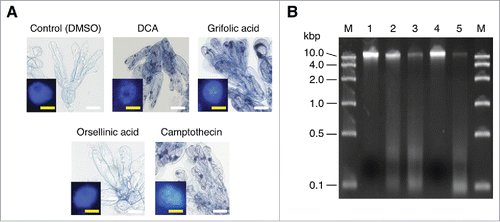Figures & data
Figure 1. Biosynthesis of daurichromenic acid (DCA). DCA is synthesized by DCA synthase via stereoselective oxidocyclization of the farnesyl moiety of grifolic acid. Two electrons from the substrate are abstracted by enzyme-bound flavin adenine dinucleotide (FAD), and then transferred to molecular oxygen to release H2O2 as the by-product, as described previously.Citation4

Figure 2. Phytotoxic effects of daurichromenic acid (DCA) and grifolic acid on R. dauricum cells. (A) Trypan blue staining to evaluate cell viability. Seven-day-old cell cultures were incubated with 100 µM of each indicated compound for 24 h, then stained with trypan blue. Control cells were treated with the solvent dimethyl sulfoxide (DMSO) only. White Bar, 100 µm. Inserted images are the fluorescent detection of nuclei after staining with 4′,6-diamidino-2-phenylindole (DAPI). Yellow bar, 10 µm. (B) Agarose gel electrophoresis of genomic DNA from R. dauricum cells treated as in A. DNA was separated on a 2% agarose gel and stained with ethidium bromide. Lane M, marker DNA with the indicated sizes; lane 1, control cells; lane 2, DCA-treated cells; lane 3, grifolic acid-treated cells; lane 4, orsellinic acid-treated cells; and lane 5, camptothecin-treated cells.

